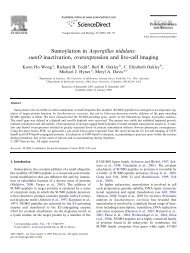Ice nucleation active bacteria and their potential role in precipitation
Ice nucleation active bacteria and their potential role in precipitation
Ice nucleation active bacteria and their potential role in precipitation
Create successful ePaper yourself
Turn your PDF publications into a flip-book with our unique Google optimized e-Paper software.
ERCA 6 89<br />
Figure 1. Transmission electron microscope image of a cell of the plant pathogenic <strong>and</strong> ice <strong>nucleation</strong> <strong>active</strong><br />
bacterium Pseudomonas syr<strong>in</strong>gae pv. aptata. The cell is ca. 2.7 μm long. Several polar flagella <strong>and</strong> bits of broken<br />
flagella are visible.<br />
found capable of withst<strong>and</strong><strong>in</strong>g a temperature of 121 ◦ C, the st<strong>and</strong>ard temperature of sterilization [9].<br />
Although extreme, these environments might offer physical conditions that are more stable than those on<br />
the surface of a leaf where fluctuations <strong>in</strong> temperature, availability of water <strong>and</strong> nutrients <strong>and</strong> <strong>in</strong>cident<br />
radiation are dramatic over both the short term (daily cycle) <strong>and</strong> the long term (seasons) [10].<br />
The microbiology of aerial plant parts has been an <strong>active</strong> field of <strong>in</strong>vestigation s<strong>in</strong>ce 1970 <strong>and</strong><br />
comprehensive reviews <strong>and</strong> texts on the subject are published regularly [11-19]. In the next paragraphs<br />
we will describe some of the aspects of microbial life on aerial plant parts with particular reference<br />
to those that could <strong>in</strong>fluence the uptake <strong>in</strong>to <strong>and</strong> fate <strong>in</strong> the atmosphere of ice <strong>nucleation</strong> <strong>active</strong> (INA)<br />
<strong>bacteria</strong>.<br />
3.1. Orig<strong>in</strong> <strong>and</strong> fate of leaf surface colonists: com<strong>in</strong>gs <strong>and</strong> go<strong>in</strong>gs<br />
A newly emerg<strong>in</strong>g leaf from the grow<strong>in</strong>g top of a plant <strong>in</strong>itially carries very few microorganisms. Yet,<br />
dur<strong>in</strong>g the life cycle of a plant, this leaf will be colonized by large numbers of microorganisms, especially<br />
<strong>bacteria</strong>. The colonization of leaves by microorganisms has been likened to the colonization of isl<strong>and</strong>s<br />
where <strong>in</strong>dividuals can immigrate to a leaf, f<strong>in</strong>d a niche, survive <strong>and</strong> multiply. Individuals can also be lost<br />
from the population via death <strong>and</strong> emigration. These processes are affected by environmental conditions<br />
<strong>and</strong> plant species.<br />
Where do these microorganisms come from? For several plant pathogens, a first source is the seed.<br />
When the seed germ<strong>in</strong>ates, microorganisms beg<strong>in</strong> to grow on the exudates of the seed (rich <strong>in</strong> nutrients)<br />
<strong>and</strong> multiply on the seedl<strong>in</strong>g, coloniz<strong>in</strong>g the newly emerg<strong>in</strong>g leaves [20-23]. Some foliar pathogens<br />
have been reported to persist <strong>in</strong> the soil, thus be<strong>in</strong>g able to bridge the gap between an annual crop <strong>and</strong><br />
the subsequent one [24]. In woody perennial plants, <strong>bacteria</strong> over-w<strong>in</strong>ter <strong>in</strong> dormant buds [25]. Plant









